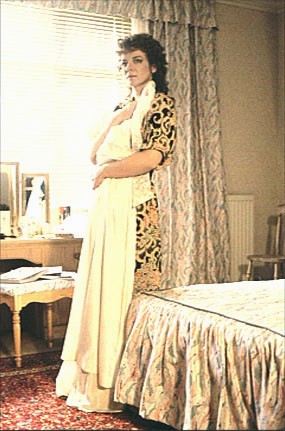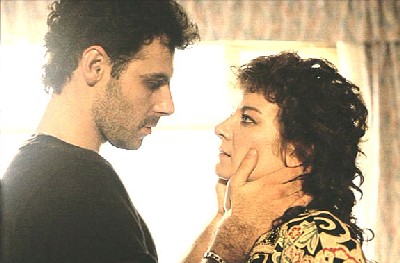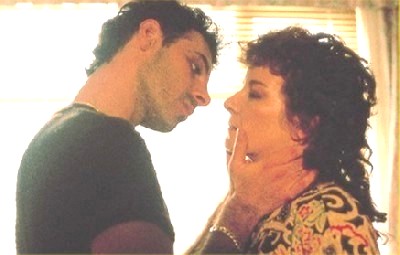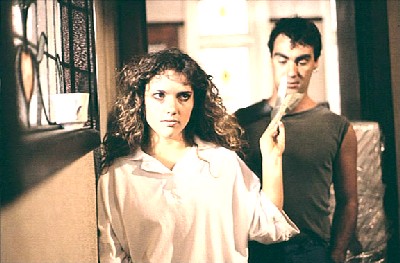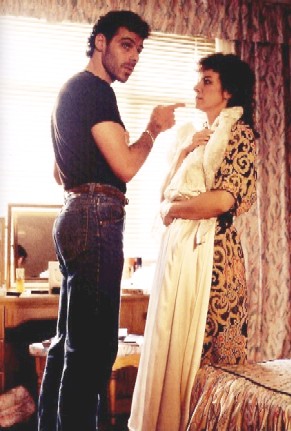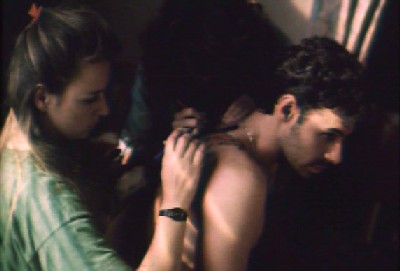A scene often changes radically between first conception in the writer's mind and its final publication or public airing.
This is perhaps especially so in the melting pot of collaborative effort on a movie and the sequence we've chosen below
charts the progress from page to screen of a classic scene from Hellraiser,
from novella to draft script to shooting script to the editing suite...
The scene recounts the one and only sexual consumation between Julia and her husband-to-be's
brother, Frank, before the wedding. Julia recalls the encounter as she stands alone in the room in which, unknown to her, Frank subsequently
encountered the Cenobites. The scene concludes with the shedding of her husband's blood which serves as a conduit to
allow Frank's return.
Comments On The Scene
 "Hellraiser was my first movie as writer/director, putting aside the usual eight- and sixteen-millimetre experiments which gather dust
beneath the beds of most film-makers. I had penned two pictures previous to it, one called Underworld (a.k.a. Transmutations), the other
an adaptation of a story of mine called Rawhead Rex. While the latter has its admirers (I'm not numbered amongst them) the former is,
I think, an unmitigated disaster, produced without the least imaginative flair by men who were later to voice their contempt for my
world-view (one likened my ideas to pornography) and who felt morally and artistically superior to both this writer and his audience. I
had no wish to repeat the experiences, but I did want to put some of the ideas bubbling up behind my eyes on the screen.
Hellraiser, which was ably produced by Christopher Figg and Christopher Webster, was the consequence of that desire:
a low-budget movie in which a novice attempted to make cinema.
"Hellraiser was my first movie as writer/director, putting aside the usual eight- and sixteen-millimetre experiments which gather dust
beneath the beds of most film-makers. I had penned two pictures previous to it, one called Underworld (a.k.a. Transmutations), the other
an adaptation of a story of mine called Rawhead Rex. While the latter has its admirers (I'm not numbered amongst them) the former is,
I think, an unmitigated disaster, produced without the least imaginative flair by men who were later to voice their contempt for my
world-view (one likened my ideas to pornography) and who felt morally and artistically superior to both this writer and his audience. I
had no wish to repeat the experiences, but I did want to put some of the ideas bubbling up behind my eyes on the screen.
Hellraiser, which was ably produced by Christopher Figg and Christopher Webster, was the consequence of that desire:
a low-budget movie in which a novice attempted to make cinema.
"It, like its sibling Nightbreed, is full of errors of judgment: but they are both films that spring from a very particular imagination
(neither, I hope, are predictable pictures) and both were certainly made with much care and consideration. I think back to the making of
Hellraiser with unalloyed fondness. Much to my delight I found myself in the company of men and women who were genuinely excited
by the challenge of bringing these scenes to the screen, and making them spring to life there. The cast treated my ineptitudes kindly,
and the crew were no less forgiving. In the editing room Richard Marden was the soul of tact, and later, when Christopher Young came to
lend his extraordinary music to the project, he gave me a swift education in the business of spotting and scoring."
Out Of My Skull
Introduction by Clive Barker to The Hellraiser Chronicles, February 1992
 "I've worked [the Hellraiser screenplay] through in great detail. When
an actor asks, 'What's my motivation?' I know exactly what to tell
them. It was my novella and its been through many drafts as a
screenplay. The narrative problems were solved a long time ago."
"I've worked [the Hellraiser screenplay] through in great detail. When
an actor asks, 'What's my motivation?' I know exactly what to tell
them. It was my novella and its been through many drafts as a
screenplay. The narrative problems were solved a long time ago."
A Literary Hellraiser
By Bob Morrish,
Cinefantastique, Vol 17 No 5, September 1987
 "I've always written sexual fiction. There is a strong theme of
rampant passion and uncontrollable desire going through my written
work, and the challenge was to see if I could make that work in a
movie. When sex raises its interesting head in most low-budget horror
movies it's strictly as exploitation. The girl goes into the shower,
the man with the ski-mask follows with a machete...
"I've always written sexual fiction. There is a strong theme of
rampant passion and uncontrollable desire going through my written
work, and the challenge was to see if I could make that work in a
movie. When sex raises its interesting head in most low-budget horror
movies it's strictly as exploitation. The girl goes into the shower,
the man with the ski-mask follows with a machete...
"What I wanted to do with Hellraiser was to give the audience some
real adult character motivations - the desire of Sean Chapman's
character, Frank, to have an experience he's never had before and the
desire of Clare Higgins's character, Julia, to have back a lover who
once gave her an afternoon of extraordinary delight. Most horror movie
characters have motivations that are very two-dimensional and they tend
not to develop as a result of that. It's not like that here. Julia is a
very complicated character: lost, lonely, pissed-off with her husband.
She's much more interesting than your average horror movie heroine."
Hellbent On Horror
By Allan Bryce,
Photoplay, Vol 38 No 9, September 1987
 "What I wanted to do was make the best looking picture I could within
the budget, and, yes, I am pleased with the result. The only thing
we had to change along the way was the sex scene during Julia's
flashback near the start of the film. In place of the scene that is
there now, we had another which was much more explicit and fleshy but
unfortunately detailed activities which are illegal in several states
around America! I thought it worked very well, and New World had raised
no objections but we had to re-shoot the material."
"What I wanted to do was make the best looking picture I could within
the budget, and, yes, I am pleased with the result. The only thing
we had to change along the way was the sex scene during Julia's
flashback near the start of the film. In place of the scene that is
there now, we had another which was much more explicit and fleshy but
unfortunately detailed activities which are illegal in several states
around America! I thought it worked very well, and New World had raised
no objections but we had to re-shoot the material."
Hellraiser
By David J Howe,
Starburst, No 110, October 1987
 "[The Engineer] wasn't included at New World's insistence, though it
wasn't in the first draft of the screenplay. But it was to do with
their desire for a more commercial picture that certain elements of the
first draft of the script got changed, sometimes very constructively.
For example, the father/daughter relationship was changed from the
story The Hellbound Heart at their suggestion. But I have no bad
word to say about New World. They took on a first-time director and a
first-time producer, they gave an adequate amount of money and, when
they saw we were producing good work, they gave us a bit more. I had
no bad times with them, they were very supportive of my vision, if you
like... Well, we did have a slight problem with the eroticism. I
shot a much hotter flashback sequence than they would allow us to cut
in.... Mine was more explicit and less violent. They wanted to
substitute one kind of undertow for another. I had a much more
explicit sexual encounter between Frank and Julia, but they said no,
let's take out the sodomy and put in the flick knife."
"[The Engineer] wasn't included at New World's insistence, though it
wasn't in the first draft of the screenplay. But it was to do with
their desire for a more commercial picture that certain elements of the
first draft of the script got changed, sometimes very constructively.
For example, the father/daughter relationship was changed from the
story The Hellbound Heart at their suggestion. But I have no bad
word to say about New World. They took on a first-time director and a
first-time producer, they gave an adequate amount of money and, when
they saw we were producing good work, they gave us a bit more. I had
no bad times with them, they were very supportive of my vision, if you
like... Well, we did have a slight problem with the eroticism. I
shot a much hotter flashback sequence than they would allow us to cut
in.... Mine was more explicit and less violent. They wanted to
substitute one kind of undertow for another. I had a much more
explicit sexual encounter between Frank and Julia, but they said no,
let's take out the sodomy and put in the flick knife."
Clive Barker
By Nigel Floyd,
Samhain, No 4, July 1987
 "New World were very keen on the flick knife cutting the strap during Julia and Frank's love making scene. I lost the situation I'd written,
which was that they fuck like crazy. I wanted to motivate her with this incredibly raunchy sex scene, they said, 'Sorry, we simply can't
use this material because you can't mix sex with violence.' It was so good too, she looked wonderful. I could only hint at that and we
came up with the solution of the slightly more threatening thing. I was very, very uncomfortable with that, and I told them I was
politically uncomfortable with it."
"New World were very keen on the flick knife cutting the strap during Julia and Frank's love making scene. I lost the situation I'd written,
which was that they fuck like crazy. I wanted to motivate her with this incredibly raunchy sex scene, they said, 'Sorry, we simply can't
use this material because you can't mix sex with violence.' It was so good too, she looked wonderful. I could only hint at that and we
came up with the solution of the slightly more threatening thing. I was very, very uncomfortable with that, and I told them I was
politically uncomfortable with it."
Weaveword
By Brigid Cherry, Brian Robb and Andrew Wilson,
Nexus, No 4, November / December 1987
 "To avoid Kirsty, she enters the room and the audience says, 'Ah, this is where it happened,' and the memories start to come back.
They begin again and they begin to intensify and, again, it's worth noting how extraordinary Chris Young's score is here, the way that
in the next few minutes it responds with great elegance to the changes of tone and slowly escalates the action. Back to the flashback
again, the wild boy, Frank, is making his seductions. Now Chris's music begins to pick up violence, pick up energy. This whole
sequence is probably the portion of the picture which really I am proudest of, the interleafing of past and present, of memory and reality,
sex and blood-letting, which is so much a part of, thematically, what is going on in the picture. Two very attractive performers and a
bed being moved up the stairs and Chris's score all pulling together to create something I think rich and interesting.
"To avoid Kirsty, she enters the room and the audience says, 'Ah, this is where it happened,' and the memories start to come back.
They begin again and they begin to intensify and, again, it's worth noting how extraordinary Chris Young's score is here, the way that
in the next few minutes it responds with great elegance to the changes of tone and slowly escalates the action. Back to the flashback
again, the wild boy, Frank, is making his seductions. Now Chris's music begins to pick up violence, pick up energy. This whole
sequence is probably the portion of the picture which really I am proudest of, the interleafing of past and present, of memory and reality,
sex and blood-letting, which is so much a part of, thematically, what is going on in the picture. Two very attractive performers and a
bed being moved up the stairs and Chris's score all pulling together to create something I think rich and interesting.
"It's very important that this material convince the audience that Julia is missing this man, that it was something exceptional that went
on between them because she's going to do a lot for this guy in the next hour or so's screentime, she's going to commit murder for him
and so we have to believe that she's, after all this time, obsessed with him still. Meanwhile, poor Larry, poor cuckolded Larry is lifting
the bed, the marital bed, up the stairs and I think there's a nice association of pleasure and imminent pain, orgasm and blood-letting."
Hellraiser
Audio commentary by Barker on the Lumivision laserdisc, 1996
Christopher Young: "The most advantageous thing, in terms of Clive providing information that affected my perception of the
film, was that he didn't want the music to be like Nightmare On Elm Street 2, he didn't want this wall-to-wall horror music, Rather Clive
felt, as did I, that this was a very strong romantic tragedy about a woman who becomes wrongly obsessed with a person who does
nothing but ill to everyone he comes in contact with. That's the part of the film Clive wanted me to concentrate on. In fact my favorite
cue in the entire picture is not the waltz, but the cue in which Julia has a flashback recalling the day when Frank, her husband's
brother, shows up to her house and they make love. I think that scene was critical in making everyone understand the depth of her
need to give Frank what he desired from her. There was this psychological obsession on her part. I do believe the music helped make
you empathise with her and have a better understanding of their relationship, so that everything that came after it became credible.
"As I recall Rudy, that was the only time ever that I remember where we cut that cue in and we played the music against the scene in
the cutting room at New World Pictures. I was there with the music editor and Tony Randel. Clive wasn't even there, he was still in
England. The scene played on as there was total silence in the room. I was really tired, really tired. I stepped outside the room and I
started crying. Tony came out, we were hugging each other. It made me realize, this is what makes film music wonderful, we all
really felt the magic of how the music changed the scene. It had a lot to do with me being up all night long for the last three days.
We were hugging; Tony and Clive were both thrilled with that cue. I'd have to say that's my favourite cue."
A Life's Work
By Rudy Koppl, Music From The Movies, No 20, Summer 1998
Christopher Young: "For the first time I understood exactly what was going on in that woman's mind. And that's what film music is all about. Giving the opportunity to have complete mental and emotional contact with that person on that screen in that situation. I was so overwhelmed by her pain when I heard the music added.
"I think that cue is, to date, the best thing that I've done. Not musically, necessarily, but just in feeling as though I've accomplished the job that every film composer hopes that he can do."
The Score
By Randall D. Larson, Cinefantastique, Vol 18 No 4, May 1988
 "Robin Vidgeon just loved to shoot women, he really did, he loved that.
"Robin Vidgeon just loved to shoot women, he really did, he loved that.
"We did a version of this which had some spanking in it and the MPAA was not very appreciative of that (Lord knows where the
spanking footage is...) but they had said - and this is the honest truth - they actually couple on the bed in a little while, the MPAA told
me that I was allowed two consecutive buttock thrusts but a third would be deemed obscene.
"What is very perverse and fun about this is, here's the moving of the mattress and here's the nail and here's the fucking, so we're
backing and forthing between the nailing and the nail...
"It's a nice interweaving and there's a lot of plot elements revealed in all of that.
"This was very simple, this was just rigging blood to come up through the nail holes and then filming it in reverse. And this is where
we had the fake room because we move below the floor, there's a little plastic bag there which was being inflated, I think probably by
Bob Keen's breath."
Hellraiser
Audio commentary by Barker on the Anchor Bay DVD, 2000
 "The blood gag didn't work the first two or three times we did it, it took quite a while to do. Such a simple thing but it took a while to do.
"The blood gag didn't work the first two or three times we did it, it took quite a while to do. Such a simple thing but it took a while to do.
"There's and interesting promise, a promise which in fact she makes good on as the movie goes on: 'I'll do anything you want.'
"And now we start to feel maybe the almost mystical power that blood has in the movie, here's our man now bringing his wounded
hand across the room and these big slow drops of blood hitting the floor. Maybe the audience is familiar with horror movies, they're
already going to have a pretty good idea of what's going on here, they're going to get a real sense of what shots like that really
mean - something vampyric about what Frank, who's waiting embryonically under the floor, does with blood.
"A very simple reverse gag. This was a set... and for obvious reasons we needed the puppeteer stuff beneath it and we had that shot,
which I think is fun, a little plastic bag being inflated by a special effects man's breath."
Hellraiser
Audio commentary by Barker on the Lumivision laserdisc, 1996
Scenes That Got Away...
The editing of the sex scene as recorded in Richard Marden's working copy of the script records some of the longer sequence
of scenes shot and edited but then ultimately cut from the theatrical version of the movie and now lost.
690-2
Frank cuts strap - touches breast - then down with Frank's hand
693-1
Wedding dress on bed - Julia then Frank fall on it
694-1
3 mins of fucking etc - stops + starts - Frank rests on Julia
695 -
C/U left breast kissed - and revealed
696 -
Frank's hand moving up Julia's left leg
697 - 3
Frank's naked bottom on top of Julia - fucking movements
698 - 2
Julia's left hand grabbing wedding dress - for orgasm
699 - 1
Frank's jeans pushed down to reveal naked bum
700 - 1
C/U Julia being kissed etc - orgasm etc
701 -1
Julia sits on Frank's cock - Frank back to cam - 2 shot
702 -
As above C/U Julia
Some photographs remain of the early stages of the flashback sex scene taken as originally shot which show Julia in a different dress
and a different bedcover on the bed.
The interaction between Kirsty and the two removal men in which she signs for or pays for the mattress.
Behind the scenes of the original flashback sex scene.
|
"Hellraiser was my first movie as writer/director, putting aside the usual eight- and sixteen-millimetre experiments which gather dust beneath the beds of most film-makers. I had penned two pictures previous to it, one called Underworld (a.k.a. Transmutations), the other an adaptation of a story of mine called Rawhead Rex. While the latter has its admirers (I'm not numbered amongst them) the former is, I think, an unmitigated disaster, produced without the least imaginative flair by men who were later to voice their contempt for my world-view (one likened my ideas to pornography) and who felt morally and artistically superior to both this writer and his audience. I had no wish to repeat the experiences, but I did want to put some of the ideas bubbling up behind my eyes on the screen. Hellraiser, which was ably produced by Christopher Figg and Christopher Webster, was the consequence of that desire: a low-budget movie in which a novice attempted to make cinema.
"I've worked [the Hellraiser screenplay] through in great detail. When an actor asks, 'What's my motivation?' I know exactly what to tell them. It was my novella and its been through many drafts as a screenplay. The narrative problems were solved a long time ago."
"I've always written sexual fiction. There is a strong theme of rampant passion and uncontrollable desire going through my written work, and the challenge was to see if I could make that work in a movie. When sex raises its interesting head in most low-budget horror movies it's strictly as exploitation. The girl goes into the shower, the man with the ski-mask follows with a machete...
"What I wanted to do was make the best looking picture I could within the budget, and, yes, I am pleased with the result. The only thing we had to change along the way was the sex scene during Julia's flashback near the start of the film. In place of the scene that is there now, we had another which was much more explicit and fleshy but unfortunately detailed activities which are illegal in several states around America! I thought it worked very well, and New World had raised no objections but we had to re-shoot the material."
"[The Engineer] wasn't included at New World's insistence, though it wasn't in the first draft of the screenplay. But it was to do with their desire for a more commercial picture that certain elements of the first draft of the script got changed, sometimes very constructively. For example, the father/daughter relationship was changed from the story The Hellbound Heart at their suggestion. But I have no bad word to say about New World. They took on a first-time director and a first-time producer, they gave an adequate amount of money and, when they saw we were producing good work, they gave us a bit more. I had no bad times with them, they were very supportive of my vision, if you like... Well, we did have a slight problem with the eroticism. I shot a much hotter flashback sequence than they would allow us to cut in.... Mine was more explicit and less violent. They wanted to substitute one kind of undertow for another. I had a much more explicit sexual encounter between Frank and Julia, but they said no, let's take out the sodomy and put in the flick knife."
"New World were very keen on the flick knife cutting the strap during Julia and Frank's love making scene. I lost the situation I'd written, which was that they fuck like crazy. I wanted to motivate her with this incredibly raunchy sex scene, they said, 'Sorry, we simply can't use this material because you can't mix sex with violence.' It was so good too, she looked wonderful. I could only hint at that and we came up with the solution of the slightly more threatening thing. I was very, very uncomfortable with that, and I told them I was politically uncomfortable with it."
"To avoid Kirsty, she enters the room and the audience says, 'Ah, this is where it happened,' and the memories start to come back. They begin again and they begin to intensify and, again, it's worth noting how extraordinary Chris Young's score is here, the way that in the next few minutes it responds with great elegance to the changes of tone and slowly escalates the action. Back to the flashback again, the wild boy, Frank, is making his seductions. Now Chris's music begins to pick up violence, pick up energy. This whole sequence is probably the portion of the picture which really I am proudest of, the interleafing of past and present, of memory and reality, sex and blood-letting, which is so much a part of, thematically, what is going on in the picture. Two very attractive performers and a bed being moved up the stairs and Chris's score all pulling together to create something I think rich and interesting.
"Robin Vidgeon just loved to shoot women, he really did, he loved that.
"The blood gag didn't work the first two or three times we did it, it took quite a while to do. Such a simple thing but it took a while to do.
